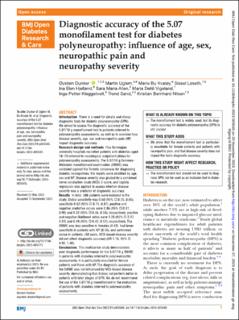| dc.description.abstract | Introduction There is a need for simple and cheap diagnostic tools for diabetic polyneuropathy (DPN). We aimed to assess the diagnostic accuracy of the 5.07/10 g monofilament test in patients referred to polyneuropathy assessments, as well as to examine how disease severity, age, sex and neuropathic pain (NP) impact diagnostic accuracy.
Research design and methods Five Norwegian university hospitals recruited patients with diabetes aged 18–70 referred to neurological outpatient clinics for polyneuropathy assessments. The 5.07/10 g Semmes-Weinstein monofilament examination (SWME) was validated against the Toronto consensus for diagnosing diabetic neuropathies; the results were stratified by age, sex and NP. Disease severity was graded by a combined nerve conduction study (NCS) Z-score, and logistic regression was applied to assess whether disease severity was a predictor of diagnostic accuracy.
Results In total, 506 patients were included in the study. Global sensitivity was 0.60 (95% CI 0.55, 0.66), specificity 0.82 (95% CI 0.75, 0.87), positive and negative predictive values were 0.86 (95% CI 0.81, 0.90) and 0.52 (95% CI 0.46, 0.58), respectively, positive and negative likelihood ratios were 3.28 (95% CI 2.37, 4.53) and 0.49 (95% CI 0.42, 0.57), respectively. The SWME was less sensitive in females (0.43), had lower specificity in patients with NP (0.56), and performed worse in patients ≥50 years. NCS-based disease severity did not affect diagnostic accuracy (OR 1.15, 95% CI 0.95, 1.40).
Conclusions This multicenter study demonstrates poor diagnostic performance for the 5.07/10 g SWME in patients with diabetes referred to polyneuropathy assessments; it is particularly unsuited for female patients and those with NP. The diagnostic accuracy of the SWME was not influenced by NCS-based disease severity, demonstrating that it does not perform better in patients with later stages of DPN. We do not recommend the use of the 5.07/10 g monofilament in the evaluation of patients with diabetes referred to polyneuropathy assessments. | en_US |

